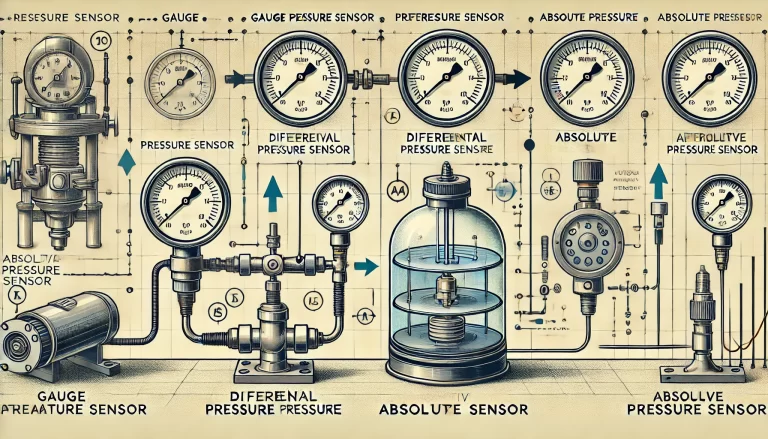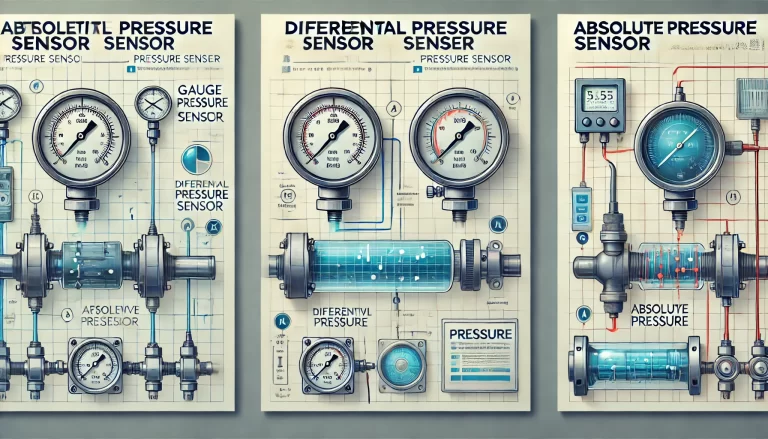In modern technology and industrial applications, pressure sensors play a crucial role as essential measurement tools. Among them, gauge pressure sensors, differential pressure sensors, and absolute pressure sensors stand out as the three core categories in the field of pressure measurement. This article delves deeply into the definitions, working principles, measurement objects, application scenarios, and distinctions of these three types of sensors, offering a comprehensive guide for their selection and use.
1. Gauge Pressure Sensors
Definition and Working Principle
A gauge pressure sensor measures relative pressure, specifically the pressure value relative to atmospheric pressure. It typically comprises a sensing element (such as a strain gauge or piezoresistive element) and an electronic circuit that converts pressure into an electrical signal. When external pressure is applied to the sensing element, the element undergoes minute deformation, causing changes in resistance. These changes are then converted by the electronic circuit into an electrical signal corresponding to the pressure.
Measurement Objects and Applications
Gauge pressure sensors are widely used in industrial automation, fluid control, and level measurement. For instance:
In chemical plants, they measure pipeline pressure to ensure safe operations.
In automotive applications, they monitor tire pressure, providing drivers with vital information about tire conditions.
In medical devices, such as ventilators, they regulate and monitor airflow to ensure proper operation.
Key Characteristics
Reference Point: Atmospheric pressure.
Measurement Range: Broad, suitable for both high and low-pressure applications.
Common Use Cases: Safety monitoring in pipelines, HVAC systems, and fluid level detection.

2. Differential Pressure Sensors
Definition and Working Principle
Differential pressure sensors measure the pressure difference between two points. They typically feature two chambers connected to the media being measured. The working principle involves the measured pressure acting directly on a diaphragm, causing micro-displacements proportional to the pressure difference. This displacement alters resistance, and the electronic circuit processes these changes into a standardized pressure measurement signal.
Measurement Objects and Applications
Differential pressure sensors are extensively used in:
Flow Measurement: Determining the flow rate in pipes by measuring the pressure drop.
Filter Monitoring: Assessing the blockage level of air filters in HVAC systems to prompt timely replacement.
Automotive Systems: Measuring exhaust pressure differences in diesel particulate filters to trigger regeneration cycles.
Key Characteristics
Reference Points: Two separate measurement points.
Measurement Range: Generally used for small pressure differences.
Common Use Cases: Process control, energy management, and emissions monitoring.
3. Absolute Pressure Sensors
Definition and Working Principle
An absolute pressure sensor measures pressure relative to a vacuum or absolute zero point. Unlike gauge pressure sensors, absolute pressure sensors factor in environmental air pressure. Their working principle is similar but uses an absolute vacuum as the reference point.
Measurement Objects and Applications
Absolute pressure sensors are particularly suited for applications requiring precise measurements:
Meteorological Observations: Measuring atmospheric pressure for weather forecasting.
Altitude Measurement: Monitoring pressure at high altitudes in aviation and space exploration.
Medical Applications: Regulating gas pressure in devices like anesthetic equipment.
Key Characteristics
Reference Point: Absolute vacuum.
Measurement Range: Application-specific, often used in conditions requiring high precision.
Common Use Cases: High-altitude research, engine optimization, and gas flow control.
4. Key Differences Among the Sensors
| Aspect | Gauge Pressure Sensors | Differential Pressure Sensors | Absolute Pressure Sensors |
|---|---|---|---|
| Reference Point | Atmospheric pressure | Two measurement points | Absolute vacuum |
| Measurement Type | Relative to atmospheric pressure | Difference between two pressures | Relative to vacuum |
| Applications | Industrial automation, automotive | Flow measurement, filter monitoring | Meteorology, medical devices |
| Measurement Range | Broad | Narrow, small differences | Application-dependent |
5. Practical Considerations for Sensor Selection
When choosing a pressure sensor, it is essential to consider:
Application Requirements: Is the focus on relative pressure, pressure differences, or absolute measurements?
Environmental Conditions: Factors like temperature, humidity, and exposure to corrosive substances.
Performance Metrics: Sensitivity, accuracy, and response time.
Budget and Longevity: Balancing cost against long-term reliability and maintenance needs.
Additionally, modern sensors often incorporate advanced features such as digital outputs, wireless connectivity, and self-diagnostic capabilities, making them more adaptable to IoT and Industry 4.0 environments.

6. Future Trends
As technology evolves, pressure sensors are expected to become more precise, compact, and versatile. Key trends include:
Integration with AI: Enhanced predictive maintenance and process optimization.
Nanotechnology: Developing ultra-sensitive sensors for niche applications.
Sustainability: Creating sensors with lower energy consumption and recyclable components.
Conclusion
Gauge pressure sensors, differential pressure sensors, and absolute pressure sensors are indispensable in various industrial and scientific applications. By understanding their working principles, measurement objects, and application scenarios, users can make informed choices to meet specific requirements. As advancements in technology continue, these sensors will undoubtedly play an even greater role in driving innovation and efficiency across industries.
